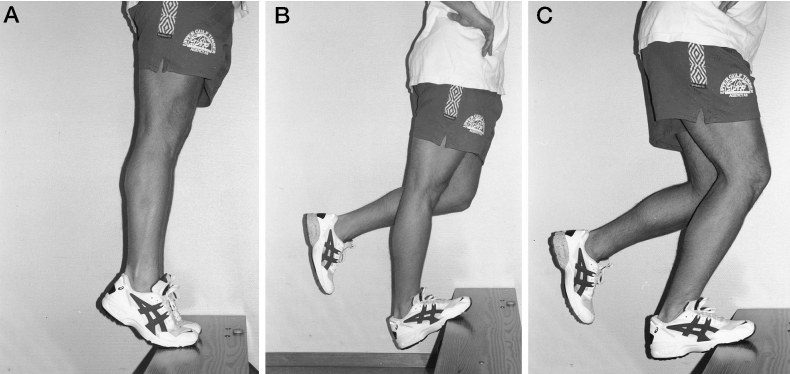When I transitioned from heel striking to forefoot running, I wore the wrong shoes, the Nike Free 5.0, I did too much too soon, partly because forefoot running felt so good, I didn’t want to stop. Consequently, I partially tore my Achilles tendon.
- Forefoot running is not a risk factor for Achilles tendinopathy, it’s doing too much too soon that causes the condition.
Achilles Rehabilitation
If you have suffered an Achilles injury from forefoot running, eccentric heel drop exercises (shown below) are one of the best methods to strengthen the tendon.
Start by standing on the edge of a step and stand high up on your toes, both feet on the step. Next, lift up one leg, and slowly lower the heel of the foot that is on the edge of the step. Lower your body down until you feel the stretch. Now, raise your body back up on to the toes and repeat.
Eccentric heel drops lengthen the Achilles tendon and a longer Achilles tendon is associated with greater elastic strain energy storage.
Also, eccentric heel drops was highly effective in breaking-up scar tissue and preventing loss of range of motion in runners with a partially torn Achilles tendon.
Since I partially tore my Achilles, I did eccentric heel drops exercises twice a day, everyday: once in the morning and later in the afternoon, until the pain was gone. I did 3 sets of 15. Within one month, I was back forefoot running again.
Ultimately, forefoot running is a form of eccentric loading because the heel is lowered to the ground after the forefoot has made ground contact. Therefore, light runs, making sure you forefoot strike properly, with periods of walking, may help overcome Achilles pain.
Avoid Icing Achilles Injury
New evidence has confirmed that the Achilles tendon may not become inflamed when injured. Hence, why Achilles tendonitis is now called Achilles tendinopathy, and why you should never ice the tendon, because there is no inflammation!
What accounts for the bilateral swelling?
The bilateral swelling is due to abnormal collagen fibers that recruit in response to tearing of the tendon. This is why icing will not help because there is no swelling from inflammation!
More From Run Forefoot:
- Pros and Cons of Minimalist Running Shoes
- Reviews and Recommendations on Barefoot-Inspired Running Shoes for Forefoot Running
- Dangers of Orthotics for Runners
- 2 Ways Heel Strike Running Causes Stress Fracture
Run forefoot, you are faster than you think!!
Bretta Riches
BSc Neurobiology; MSc Biomechanics candidate, ultra minimalist runner & founder of RunForefoot. I was a heel striker, always injured. I was inspired by the great Tirunesh Dibaba to try forefoot running. Now, I'm injury free. This is why I launched Run Forefoot, to advocate the health & performance benefits of forefoot running and to raise awareness on the dangers of heel striking, because the world needs to know.
Latest posts by Bretta Riches (see all)
- Does Foot Strike Really Matter in Running? YES! - 17/04/2024
- Heel Lifts Increase Injury in Runners - 16/04/2024
- Are Minimalist Shoes Good for Seniors? YES! - 14/04/2024


Leave a Reply